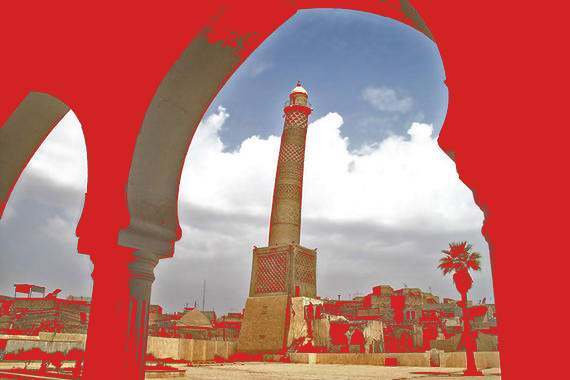
Iraqi officials say Islamic State destroyed historic mosque and minaret in Mosul
They were ancient monuments that would be more remembered for their modern history: the site where Islamic State’s leader, Abu Bakr Baghdadi, declared himself “caliph” three years ago. And their capture by government forces was to be a symbol of Islamic State’s defeat in what was once its Iraqi capital.
Instead, Mosul’s most famous landmarks, the Great Nuri Mosque and the leaning minaret known as the Hadba or “hunchback,” were destroyed by the militant group on Wednesday, government officials said.
In their battle to retake the city, commandos from Iraq’s elite Counter-Terrorism Service had fought their way to within 50 yards of the landmarks when militant fighters blew them up, the government said.
The 900-year-old mosque was named after Nur Al-Din Zenki, the Zengid leader who wanted to unite all Muslims to fight the Crusaders.
Since Islamic State’s blitz through territory in Iraq and Syria in 2014, the mosque was widely known as the place where Baghdadi gave his first speech as self-declared caliph.
A photo from a drone flying over the the mosque and the minaret, released by the local news outlet Sumariya, shows only a small dome in the middle of the site still standing.
A video released later Wednesday shows the minaret at the moment of its destruction. The camera lingers on the minaret before rings of dust burst from its 148-foot length. The detonation rips through the rest of the structure before it collapses to dust.
“The terrorist gangs of Daesh committed another history crime, the blowing up of the Nuri Mosque and the historic Hadba minaret,” Iraqi staff Lt. Gen. Abdulamir Yarallah, the overall commander of the Mosul offensive, said in a statement. He referred to Islamic State by its Arabic acronym. It is also known as ISIS.
A government offensive to retake the city was launched in October. This month, Iraqi forces breached the militant group’s last bastion in Mosul, the Old City quarter.
Brig. Gen. Yahya Rasool, spokesman of the Iraqi Joint Operations Command, said in a phone interview Wednesday that destruction of the historic structures would not stop Iraqi forces “from ousting terrorists from our land.”
Islamic State blamed a U.S. airstrike for the destruction of the site.
But Col. Ryan Dillon, spokesman for the U.S.-led coalition in Iraq and Syria, said in a phone interview, “The coalition did not conduct a strike at the time when the mosque was destroyed.”
Religious buildings, such as churches and mosques, are not normally allowed as targets for U.S. military airstrikes. The buildings can be targeted only with the approval of senior military officers, if commanders believed they have been overtaken by enemy forces.
That was not the case with the mosque, said Maj. Gen. Joseph Martin, U.S. commander of coalition ground forces.
“As our Iraqi Security Force partners closed in on the al-Nuri mosque, ISIS destroyed one of Mosul and Iraq’s great treasures,” he said in a statement. “This is a crime against the people of Mosul and all of Iraq, and is an example of why this brutal organization must be annihilated. The responsibility of this devastation is laid firmly at the doorstep of ISIS.”
Iraqi forces had for weeks stalled at more than 300 yards from the mosque before fierce resistance by the jihadis. Wednesday’s thrust was the closest they had reached to capturing a prize that was synonymous with what was once Iraq’s second-largest city.
Baghdadi took to the pulpit of the Nuri Mosque in his only appearance in an Islamic State video in July 2014, where he told his followers he was their wali, or governor.
“God gave your mujahideen brothers victory after long years of jihad and patience … so they declared the caliphate and placed the caliph in charge,” he said then.
The mosque was built around 1172. The nearby Hadba, locals would say, had gotten its tilt bowing to the prophet Muhammad as he rose up to heaven. Experts had for years tried to stabilize the minaret. When it stood, it leaned more than nine feet off the perpendicular axis.
Despite its decrepit state, it was the city’s primary icon and was often a substitute for Mosul’s name.
It was a surprise that the landmarks had stood so long under Islamic State’s reign. The group, which espouses a harsh form of sharia law, views monuments as pagan.
Less than two months after Islamic State snatched Mosul, it quickly destroyed important sites like the Prophet Yunus Shrine. It later released a video showing militants gleefully taking drills and sledgehammers to statues in the Mosul museum.
That the sites were blown up on Laylat al-Qadr , or the Night of Power, is especially bitter for many in Iraq. It is the holiest night of the Muslim calendar and commemorates when the verses of the Koran were first revealed to Muhammad.
It comes late in the month of Ramadan and is thought to be a time when sins are forgiven and supplications are accepted.
Read original article @ http://www.latimes.com/world/middleeast/la-fg-iraq-mosul-mosque-20170621-story.html